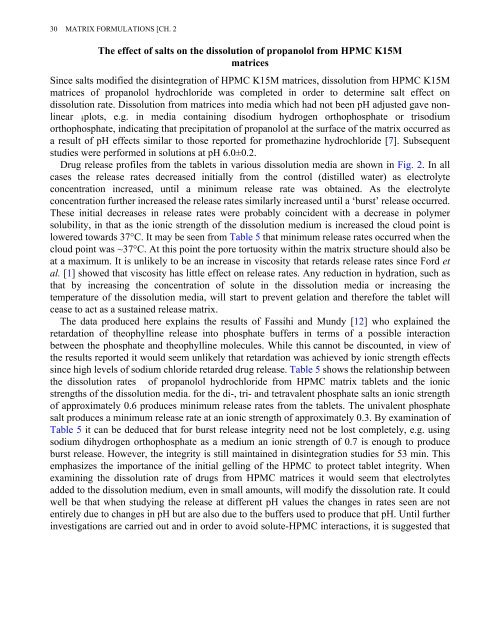Pharmaceutical Technology: Controlled Drug Release, Volume 2
Pharmaceutical Technology: Controlled Drug Release, Volume 2
Pharmaceutical Technology: Controlled Drug Release, Volume 2
You also want an ePaper? Increase the reach of your titles
YUMPU automatically turns print PDFs into web optimized ePapers that Google loves.
30 MATRIX FORMULATIONS [CH. 2<br />
The effect of salts on the dissolution of propanolol from HPMC K15M<br />
matrices<br />
Since salts modified the disintegration of HPMC K15M matrices, dissolution from HPMC K15M<br />
matrices of propanolol hydrochloride was completed in order to determine salt effect on<br />
dissolution rate. Dissolution from matrices into media which had not been pH adjusted gave nonlinear<br />
plots, e.g. in media containing disodium hydrogen orthophosphate or trisodium<br />
orthophosphate, indicating that precipitation of propanolol at the surface of the matrix occurred as<br />
a result of pH effects similar to those reported for promethazine hydrochloride [7]. Subsequent<br />
studies were performed in solutions at pH 6.0±0.2.<br />
<strong>Drug</strong> release profiles from the tablets in various dissolution media are shown in Fig. 2. In all<br />
cases the release rates decreased initially from the control (distilled water) as electrolyte<br />
concentration increased, until a minimum release rate was obtained. As the electrolyte<br />
concentration further increased the release rates similarly increased until a ‘burst’ release occurred.<br />
These initial decreases in release rates were probably coincident with a decrease in polymer<br />
solubility, in that as the ionic strength of the dissolution medium is increased the cloud point is<br />
lowered towards 37°C. It may be seen from Table 5 that minimum release rates occurred when the<br />
cloud point was ~37°C. At this point the pore tortuosity within the matrix structure should also be<br />
at a maximum. It is unlikely to be an increase in viscosity that retards release rates since Ford et<br />
al. [1] showed that viscosity has little effect on release rates. Any reduction in hydration, such as<br />
that by increasing the concentration of solute in the dissolution media or increasing the<br />
temperature of the dissolution media, will start to prevent gelation and therefore the tablet will<br />
cease to act as a sustained release matrix.<br />
The data produced here explains the results of Fassihi and Mundy [12] who explained the<br />
retardation of theophylline release into phosphate buffers in terms of a possible interaction<br />
between the phosphate and theophylline molecules. While this cannot be discounted, in view of<br />
the results reported it would seem unlikely that retardation was achieved by ionic strength effects<br />
since high levels of sodium chloride retarded drug release. Table 5 shows the relationship between<br />
the dissolution rates of propanolol hydrochloride from HPMC matrix tablets and the ionic<br />
strengths of the dissolution media. for the di-, tri- and tetravalent phosphate salts an ionic strength<br />
of approximately 0.6 produces minimum release rates from the tablets. The univalent phosphate<br />
salt produces a minimum release rate at an ionic strength of approximately 0.3. By examination of<br />
Table 5 it can be deduced that for burst release integrity need not be lost completely, e.g. using<br />
sodium dihydrogen orthophosphate as a medium an ionic strength of 0.7 is enough to produce<br />
burst release. However, the integrity is still maintained in disintegration studies for 53 min. This<br />
emphasizes the importance of the initial gelling of the HPMC to protect tablet integrity. When<br />
examining the dissolution rate of drugs from HPMC matrices it would seem that electrolytes<br />
added to the dissolution medium, even in small amounts, will modify the dissolution rate. It could<br />
well be that when studying the release at different pH values the changes in rates seen are not<br />
entirely due to changes in pH but are also due to the buffers used to produce that pH. Until further<br />
investigations are carried out and in order to avoid solute-HPMC interactions, it is suggested that

















